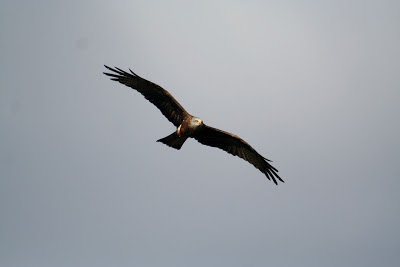It is a balmy evening, the
heat of the day having dissipated with the lowering sun. The golden sand shifts
beneath my feet as I walk down the beach, small pebbles and stones are
scattered amongst the golden grains and bunches of pale green marram grass cluster
like small islands in an ocean of yellow. The sea gently rolls up and onto the
beach, a creamy blue stretching to a hazy horizon. Behind us the tall dunes
shield the beach from view. It is like a private world. Above us is a cacophony
of sound, of birds chattering. But this is not any cacophony and not one you
will hear at every beach in the UK
The smallest of Britain'
 |
| Two very cute Little Tern chicks |
We carry on walking until
we reach the end of a fenced off area, here stepping over an electric
fence we hope the wardens have remembered to switch off, we climb into a little
tern colony. We stretch out in a line and begin slowly walking back the
way we came, eyes glued to the ground, carefully scanning the beach in front
and gently placing one foot in front of the other. Little Terns nest on the
ground, their eggs and chicks are so perfectly camouflaged they are almost
invisible. Small pebble dashed eggs or tiny fluffy, pebble dashed chicks,
silent and unmoving, they can so easily be missed.
Around the coast where the
largest Little Tern colonies remain, great lengths have been taken by a number of dedicated
people to protect them while they nest. RSPB wardens patrol beaches, talking to
beach goers, keeping them away from colonies. Electric fences have been
erected keeping people and predators out as much as possible. Colonies are
closely monitored, and as part of that monitoring and to understand where birds
are moving to, where they are returning to breed and to get an idea of growth
rates and fledging success, the chicks are ringed.
So we come full circle to
me walking in a line of people, straining my eyes in search of invisible
chicks, while adult birds wheel and dive above. But let me make it clear, I am
here by invitation only. Even as a ringer you can’t just walk into a Little Tern colony and start ringing chicks left, right and centre. You have to have a
special licence. As a ringer though you can be invited by someone who has a
licence, and under their watchful presence get to ring what have to be the
cutest, tiniest, fluffiest chicks in the world. It is a complete and utter privilege.
 |
| Ringing a Little Tern chick! |
From tiny chicks a mere
few days old that huddle in a dip together pretending not to exist, to the
larger more mobile chicks that race around, darting between hummocks of grass
before finally giving up and crouching down, all took a ring, all were weighed
and had their bills measured.
 |
| Getting weighed |
We soon reach the end of
the colony, gather up the last few chicks and once processed leave the beach to
the little terns once more. Adults swoop in, laden with fish caught nearby and
the chicks resettle. Our impression on them seems fleeting, we leave nothing
but foot prints in the sand and an extra little bit of bling on the leg….
Many thanks to the RSPB and Dave Parsons of East Norfolk Ringing Group
Many thanks to the RSPB and Dave Parsons of East Norfolk Ringing Group





